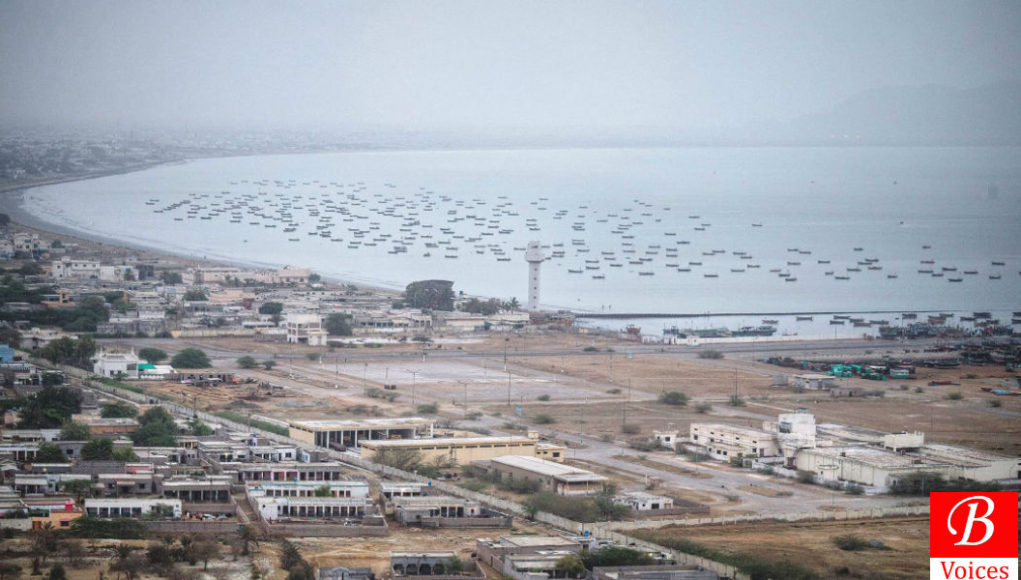Adnan Aamir
On a hot Sunday in Gwadar, a large caravan of vehicles entered the streets. Comprised of mostly SUVs and other high-end cars, the caravan was a protest rally. After moving past various places in Gwadar, the caravan stopped and leaders of the rally made speeches. This car rally was organised to register a public protest in the city. However, this protest was not for any major problems of the city itself, such as long hours of power cuts or frequent water shortages. It was against the removal of Sadiq Sanjarani from the position of chairman of the Senate.
The rally was led by Senator Kahuda Babar of Balochistan Awami Party (BAP). He was carrying out his political responsibility to defend the Senate chairman who is from his party. However, this protest does not represent sentiments of the people of Gwadar, who are still waiting for some relief in the form of development works nearly two decades after the city came in the public eye.
Gwadar emerged in 2002 when the Chinese began the construction of a port there. This port became one of the causes of the recent insurgency in Balochistan. Due to the insurgency, the port could not immediately become functional after its construction was completed in 2007. However, in April 2015, Pakistan signed the China-Pakistan Economic Corridor (CPEC) agreements with China. Gwadar was the centre stage of CPEC and it is often said that there would have been no CPEC if there was no Gwadar.
Now, after nearly four years since the inception of CPEC, not much has changed in the lives of ordinary people of the port city.
Four days after the SUV-led protest in support of Sadiq Sanjrani, there was another protest. More than 40 people representing all political parties of Gwadar and various trade unions marched to the deputy commissioner’s office. They were protesting against frequent power cuts in the city.
During summer, suspension of electricity for more than 12 hours makes life very difficult for citizens. This time the problem became so dire that the protestors offered their arrests in protest. All of them spent one night in the Levies station under voluntary arrest.
The next day they agreed to vacate the station after negotiations with the district administration. They were assured that at least 17 hours of electricity would be provided to the city. Trusting the words of the district administration, the protestors called off the strike. Till the time of the filing of this report, Gwadar was being provided 17 hours of electricity on a daily basis.
Yet, the protestors are not sure when they will have to restart protests because the problem has not been resolved on a permanent basis. It is indeed strange that the federal government cannot ensure provision of electricity to Gwadar, despite spending hundreds of billions under CPEC agreements.
Currently, Gwadar receives its electricity from Iran because this part of Balochistan is not connected with the national electric grid. According to Quetta Electricity Supply Company (QESCO), Iran is supposed to supply 100MW of electricity but currently, it is providing 50MW due to its own supply-side constraints. China Overseas Port Holding Company (COPHC) operating Gwadar port is running its own electricity generation unit to supply power to port operations. A 300 MW power plant has been approved for Gwadar but it is far from completion. Gwadar, supposedly a city of the future, does not even have enough electricity to light up all homes, let alone power any major commercial activity.
The responsibility for this crisis lies on the federal government, which controls the ministry of water and power. The federal government never prioritised powering up Gwadar and the result is hours of load shedding.
During the PML-N government, when more than 10,000 MW of electricity was added to the national grid, no arrangements were made to supply additional electricity to Gwadar. This speaks volumes about the interest of the PML-N in the development of Gwadar, despite championing the cause of CPEC during the better part of their government.
The provincial government is also responsible for the electricity crisis in Gwadar, despite not directly being in control. After the 18th Amendment, provinces can produce up to 50MW of electricity on their own. Balochistan government could have taken such an initiative for Gwadar but they did not do so.
Successive provincial governments in Balochistan have also failed to convince the federal government to power up the city. They failed to put pressure on the federal government and as a result, masses are suffering.
Some people expect China to resolve the electricity crisis in Gwadar. This is an unrealistic expectation. China is only in Gwadar to implement CPEC projects and it is not her duty to resolve internal problems of Pakistan. China is working on a 300MW power plant for Gwadar, but the project has been delayed due to bureaucratic and operational issues on part of the government. Political leaders who are pinning their hopes on China to resolve the electricity crisis are doing no good and are in fact misleading the people.
Currently, Balochistan is being ruled by the Balochistan Awami Party (BAP), which was formed with the slogan that decisions about Balochistan will be made in Balochistan. If the BAP government wants to make good on its political slogan, then the least they can do is to concentrate on the development of Gwadar. Making concrete efforts to permanently resolve the electricity crisis can be a good starting point. The last thing BAP leadership should be doing is organising elite car rallies to support their falling chairman in the Senate.
Originally published in The Friday Times
Share your comments!








